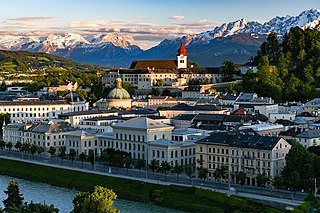
Salzburg is the fourth-largest city in Austria. In 2020, it had a population of 156,872.

Herrenchiemsee is a complex of royal buildings on Herreninsel, the largest island in the Chiemsee lake, in southern Bavaria, Germany. Together with the neighbouring isle of Frauenchiemsee and the uninhabited Krautinsel, it forms the municipality of Chiemsee, located about 60 kilometres (37 mi) southeast of Munich.

The Walhalla is a hall of fame that honours laudable and distinguished people in German history – "politicians, sovereigns, scientists and artists of the German tongue"; thus the celebrities honoured are drawn from Greater Germany, a wider area than today's Germany, and even as far away as Britain in the case of several Anglo-Saxon figures. The hall is a neo-classical building above the Danube River, in Donaustauf, east of Regensburg in Bavaria, the exterior modelled on the Parthenon in Athens.
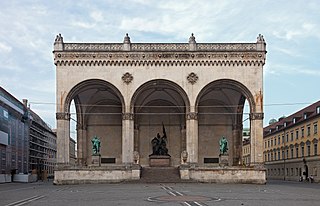
The Feldherrnhalle is a monumental loggia on the Odeonsplatz in Munich, Germany. Modelled after the Loggia dei Lanzi in Florence, it was commissioned in 1841 by King Ludwig I of Bavaria to honour the tradition of the Bavarian Army.

The University of Salzburg, also known as the Paris Lodron University of Salzburg, is an Austrian public university in Salzburg municipality, Salzburg State, named after its founder, Prince-Archbishop Paris Lodron.
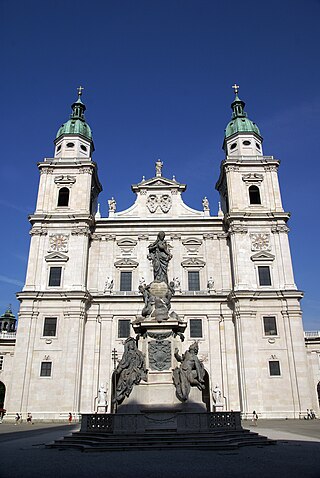
Salzburg Cathedral is the seventeenth-century Baroque cathedral of the Roman Catholic Archdiocese of Salzburg in the city of Salzburg, Austria, dedicated to Saint Rupert and Saint Vergilius. Saint Rupert founded the church in 774 on the remnants of a Roman town, and the cathedral was rebuilt in 1181 after a fire. In the seventeenth century, the cathedral was completely rebuilt in the Baroque style under Prince-Bishop Wolf Dietrich von Raitenau to its present appearance. Salzburg Cathedral still contains the baptismal font in which composer Wolfgang Amadeus Mozart was baptized.

Nonnberg Abbey is a Benedictine monastery in Salzburg, Austria. Founded c. 712/715 by Saint Rupert of Salzburg, it is the oldest continuously existing nunnery in the German-speaking world. The monastery complex is today a protected monument and part of the Historic Centre of the City of Salzburg, a UNESCO World Heritage Site since 1996.
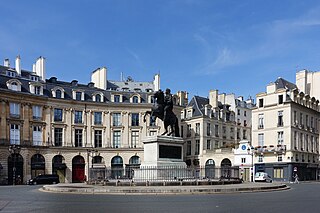
The Place des Victoires is a circular square in central Paris, located a short distance northeast of the Palais-Royal and straddling the border between the 1st and the 2nd arrondissements. The Place des Victoires is at the confluence of six streets: the Rue de la Feuillade, Rue Vide-Gousset, Rue d'Aboukir, Rue Étienne-Marcel, Rue Croix-des-Petits-Champs and Rue Catinat.
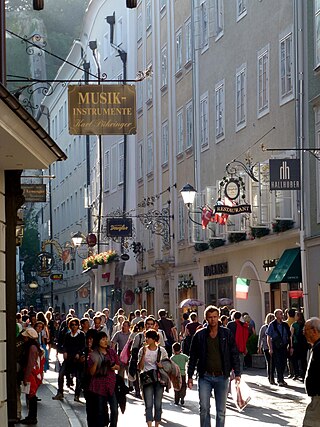
Getreidegasse is a busy shopping street in the historic Altstadt of Salzburg, Austria, a UNESCO World Heritage Site since 1996. It is known for the birthplace of Wolfgang Amadeus Mozart at No. 9, where he lived until the age of 17. The narrow street is characterised by numerous high townhouses side by side with its wrought iron guild signs.

Mirabell Palace is a historic building in the city of Salzburg, Austria. The palace with its gardens is a listed cultural heritage monument and part of the Historic Centre of the City of Salzburg UNESCO World Heritage Site.

Residenzplatz is a large, stately square in the historic centre (Altstadt) of Salzburg in Austria. Originally named Hauptplatz, it is now named after the Alte Residenz of the Prince-Archbishops of Salzburg. It is one of the city's most popular places to visit.

The Historic Centre of the City of Salzburg, also known as the Altstadt, is a district of Salzburg, Austria, recognized as UNESCO World Heritage Site since 1996. It corresponds with the historic city center, situated on the left and right banks of the Salzach river.
The Beethoven Monument is a large bronze statue of Ludwig van Beethoven that stands on the Münsterplatz in Bonn, Beethoven's birthplace. It was unveiled on 12 August 1845, in honour of the 75th anniversary of the composer's birth.

The National Kaiser Wilhelm Monument (Kaiser-Wilhelm-Nationaldenkmal) was a memorial structure in Berlin dedicated to Wilhelm I, first Emperor of Imperial Germany. It stood in front of the Berlin Palace from 1897 to 1950, when both structures were demolished by the German Democratic Republic (GDR) government.

The Wackersdorf nuclear reprocessing plant is a reprocessing plant in Wackersdorf in Bavaria, Germany. Because of protests the plant was never completed. Today it is an industrial site with no special features.

The statue of Benjamin Disraeli is an outdoor bronze sculpture by Mario Raggi, located at the west side of Parliament Square in London. It was unveiled in 1883 and became a Grade II listed building in 1970.
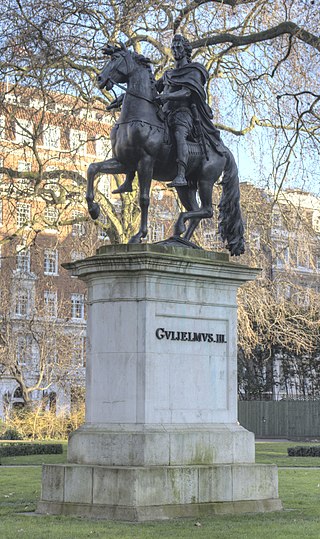
The equestrian statue of William III by John Bacon Junior stands in St James's Square in central London. It is modelled on an earlier statue of the king by John Michael Rysbrack in Queen Square, Bristol. Funding for the London statue was provided in the will of Samuel Travers, M.P., dated 1724, but nothing was done to progress the plan for a further seventy years. A design for the monument was drawn up in 1794 by Bacon's father, John Bacon Senior, but this was not executed and the commission passed to Bacon Jr., under whose direction the statue was finally erected in 1808. The statue is a Grade I listed structure.

The Mozart Monument is a monument located in the Burggarten in the Innere Stadt district of Vienna, Austria since 1953. It is dedicated to composer Wolfgang Amadeus Mozart (1756–1791).

The Sigmundstor, often still known as the Neutor, is a road tunnel in Salzburg that also forms one of the city gates of the historic Altstadt. It connects the Altstadt with the Riedenburg quarter through the Mönchsberg mountain. Built in the 18th century, it is the oldest road tunnel in Austria.




















